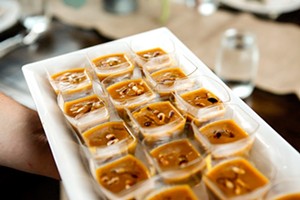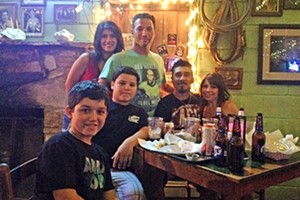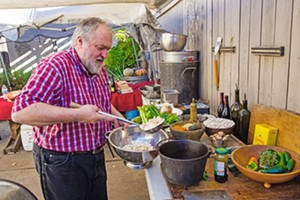Holidays by their very nature provide ample opportunity to create tradition. However, there is something about culinary practices that solidifies those traditions in a way that gift swaps, the annual portrait, or holiday outings cannot.
People create tradition with their favorite dish. Some families pass a recipe down from one generation to the next. Often certain recipes are guarded until the creator of that dish hands the duty to the next generation.
Sometimes the tradition comes from creating that dish together, sometimes a dish is special because of who made it. Or it’s just because the brain attaches memory to scent and taste, so that nostalgia seems to make a dish taste fantastic, and a delicious dish makes an event that much grander.
With that in mind we asked some Central Coast residents what food stars in their Thanksgiving dinners. Here’s what they said:
Keeping it traditional
Demetri Loizides, chef and owner of K’Syrah Catering and Events in Solvang, keeps his Thanksgiving dinners traditional. He raises his own chickens, turkeys, and squab (pigeons), and cooks an acorn squash and butternut squash soup. Each year, he welcomes about 20 friends and family members to his Solvang home to enjoy football and classic
holiday dishes.
Loizides said traditional Thanksgiving cuisine holds a particularly special place in his heart. He is from Zimbabwe originally, and his parents are Greek—but he doesn’t include Greek cuisine on the Thanksgiving menu.

“We definitely adhere more to the traditional American Thanksgiving,” Loizides told the Sun. “I’m Greek by origin. We don’t do any Greek things. We’re honoring being in the United States.”
Then again, squab—or young, domestic pigeon—isn’t exactly a dish you see on just any old Thanksgiving table. Loizides typically prepares the bird stuffed with wild rice and mushrooms, seared and slow-roasted. This will be his second year serving the dish at Thanksgiving.
“The first Thanksgiving, with the pilgrims and the Indians, would have been some kind of game bird with wild rice,” he said. “That’s how I came up with
that dish.”
Loizides raises the pigeons on his land, along with turkey, which he also dishes up as part of the traditional Thanksgiving feast. He said that market-bought turkey tends to run low in fat, because the birds are raised so quickly they don’t have the chance to develop. So he started raising his own, which he said end up with as much as a quarter-inch of fat under the skin because they eat so much better than those raised for the store.
But Loizides’ favorite Thanksgiving meal to prepare—and his guests’ favorite, according to him—is the butternut squash and acorn squash soup. It’s his longest-standing holiday dish, and he makes it from his own butternut squash.
“It seems like the most basic,” Loizides said. “But it’s usually a cold day, watching football. It’s the most homey dish, I think.”
He starts by cutting the squash into cubes and adding in herbs from his garden. He makes his own chicken broth, also using garden-grown herbs, and simmers it for a couple of hours. When he blends it all together, the result tastes and feels rich with cream.
“But there’s no cream in it,” he said. “It’s all natural.”
Loizides is already thinking about next year’s Thanksgiving, as well, which he hopes to host at the K’Syrah venue.
“So now I have to start raising turkey again in April,” he said, laughing.
Creating some cross-cultural tradition
While Thanksgiving is uniquely an American holiday, one family in Santa Maria likes to mix it up with a little bit of Mexican cuisine.
Rose Maroney is the mother of elite U.S. Air Force pararescueman Mike Maroney and has Mexican heritage. Her husband, retired Allan Hancock College Police Department Chief Wes Maroney, has Polish and Irish roots.
Rose begins the day by preparing and cooking the turkey. While that roasts, she has an assembly line for tamales ready and waiting. It’s typically a family affair.

“We’ll make them ahead in the a.m., so all you have to do is warm them up,” Rose said. “It’s a Mexican tradition to have tamales for Thanksgiving.”
The tamales become central to the meal throughout the day. Not only are they feasted upon during the day, but Rose added that it’s a tradition to have them with eggs sunny-side-up for breakfast prior to the main event—as well as for dinner.
Rose doesn’t use chicken or pork for her tamales. Rather—because it’s Santa Maria—she bucks the norm and uses tri-tip. She’ll boil the meat to tenderize it to the point where it’s falling apart. She then mixes the shredded beef with her house-made chile verde sauce and Monterey jack cheese.
Along with the tamales Rose adds menudo—the Mexican soup delicacy made with beef tripe (beef stomach)—which is also made in the morning along with the tamales.
Mike takes a different approach; he likes all of that, of course, but every now and then he’ll go for the simpler things, like turkey in a tortilla with rice and beans. It makes the holidays worthwhile.
“If you haven’t had turkey in a tortilla with beans and rice, then you haven’t experienced life,” Mike said.
For dessert, there’s the slew of pies, but Rose will make buñuelos, or fritters. There are many versions of this dessert dish throughout Latin America, but hers is essentially a fried tortilla sprinkled with cinnamon and sugar. Often, she’ll use cookie cutters to make shapes of the tortillas.
And for leftovers? Turkey tamales, of course.
But Thanksgiving isn’t only about food. It’s also about spending time with family. The holidays can be a tough time for military service members because they’re not always able to be with their families. Many are either deployed, in boot camp, or don’t have enough leave time to get home.
Mike and his dad, Wes, hold a tradition to take in service members who can’t make it to their families or don’t have a place to go. Whether they’re soldiers, airmen, or even police officers, they always have a seat at the Maroney table.
As a kind gesture one year, Mike said his dad invited a woman and her children who were about to be evicted from their home.
This year is a little different for Mike as he’ll be away for Thanksgiving. Currently stationed at Lackland Air Force Base in San Antonio, Texas, where Air Force boot camp is located, Mike is participating in Operation Home Cooking and will be hosting airmen and recruits at his home for the holidays. For one day, the operation connects local families with airmen who may be feeling a bit homesick.
Entering military boot camp can be a jarring experience for recruits, and many aren’t used to being away from home, which is why Mike will be adopting a recruit for a day.
“Some of these kids are here for Christmas and Thanksgiving,” Mike said. “That’s rough the first time out of your mom’s house.”
Although Mike finished his bootcamp right before Thanksgiving, he’s missed several holidays with the family because of deployment.
The holidays are about to become a lot more special for him.
Back in 2005, Mike made national headlines when he was deployed to New Orleans for search-and-rescue operations following Hurricane Katrina.
A photograph of him embracing a 3-year-old girl he rescued from the flooded city became iconic during the aftermath of the storm. Before Mike was able to get her name, he was quickly dispatched to rescue more stranded hurricane victims. She became known as Katrina Girl.
Ten years later, Mike launched a campaign to find the girl and he eventually did. Her name is LaShay Brown, and this year he’ll spend Christmas with her.
Adding some heartiness with buttery, earthy flavors
It’s a sunny afternoon and Stephan Bedford, owner of Bedford Winery in Los Alamos, is stirring the contents of a big, black pot that sits on his gas grill at the winery’s outdoor kitchen space. He’s preparing a dish that will make an appearance on his Thanksgiving table this year, a lima bean stew.
Bedford is fascinated by the buttery lima bean, he said, and its ability to suck up flavor from a stock. He had a vegetable stock prepared for the dish (though he will often do a pork stock with a ham hock), but he wants to be friendly to the vegetarians who might visit the winery or his holiday dinner. Meat stock or no, the dish he’s preparing will go great with another important player at his table—the wine.

“Lima beans themselves—they call them butter beans in the South—they have this incredibly delicate flavor and these earthy overtones, so when you pour it with wine, it’s just unbelievable,” Bedford said.
Stacks of books sit next to a 5-pound bag of the dried lima beans from Lompoc Valley Seed and Milling. They are filled with information about the beans, their history, and their place in Spanish and indigenous American recipes.
For Bedford, the lima bean has historical and local significance. When he first moved to the Central Coast in the 1980s he was surprised to find so many different varieties of beans being cultivated on the Central Coast, he explained. The lima bean especially falls into an aged tradition, he said.
“It’s interesting, lima beans, they’ve been cultivating these things in Mesoamerica and Peru for 4,000 years,” Bedford said. “Almost 1,000 years ago, or maybe 750, is when the baby lima came into existence in America.”
Bedford soaks the dried lima beans overnight, and once he’s got a flavorful stock ready and all of his ingredients chopped, it’s time to throw it together.
Like any good soup or stew, he begins with some fat in the pot—olive oil and butter—along with the onions, letting the flavors develop a bit before adding garlic and greens. Collards or kale are both welcome in Bedford’s pot, he said, and the greens actually help thicken the stew. He also has a curry spice ready made from fresh ground mustard, turmeric, paprika, and pepper.
“It’s incredibly easy to do, and it’s stuff you can do while you’re doing other things,” he said. “If people get involved and help, really what you’re doing mostly is preparing things: rinsing, dicing your vegetables, and adding them in at different times.”
There are other players welcome to the show as well, like peppers. He added four peppers once he got the beans, greens, and the rest to a boil—jalapeño, bell, anaheim, and poblano—for some “background.” But it isn’t until much later, right when the beans are about done that he adds the mushrooms, rehydrated Porcini and fresh button mushrooms.
When he’s cooking with collaborators, especially on holidays like Thanksgiving, the amounts of each ingredient and when they are added to the stew become a debate among everyone, Bedford said. The teamwork that comes into play adds another layer of tradition to the dish, all before everyone gets to sit down at the table to enjoy it.
“For us, tradition is one of these things where, [you wonder] why do people do this? You hear people talk about their mother doing it, and their grandmother doing it, so it’s almost like it’s imprinted on us,” he said. “Like everything with wine or food, it’s a conduit to conversation. We share it for an hour or a half hour, letting this thing unfold and develop, and you can see how the conversation around that can be interesting.”
Lightening things up with a sweet and fluffy side
There’s more to ambrosia salad than meets the eye, according to Orcutt resident Caroline Cosgrove. “There aren’t many ingredients, and they’re easy to get, but people don’t realize how crucial timing is,” Cosgrove told the Sun.
“Most people only refrigerate ambrosia for an hour or so before serving, which is nowhere near enough time,” Cosgrove said. “You have to let it sit for at least 24 hours if you want it to be nice and fluffy.”

The amount of ambrosia salad recipes available online is limitless, so what makes Cosgrove’s variation so special? “Trust me, I’ve been doing this long before the internet was even invented,” Cosgrove said, laughing.
Cosgrove, now retired, worked as a marketing supervisor at the ConTel Corporation for more than 25 years. Before ambrosia became a Thanksgiving tradition in her household, Cosgrove would make it for company potlucks and parties.
“Male coworkers would tell their wives to get the recipe from me,” Cosgrove recalled. “One even joked that he was going to get a divorce and marry me just for the ambrosia.”
Cosgrove’s recipe consists of miniature marshmallows, sour cream, fruit cocktail, maraschino cherries, fresh banana slices, and fresh apple slices. It’s rare to find an ambrosia recipe that excludes marshmallows, fruit cocktail, or cherries—but the fresh fruit aspect is almost always interchangeable. Most recipes list pineapple or orange slices, but Cosgrove stands firm on the subject. “Banana and apple slices, it’s the only way to go.”
Cosgrove also insists on using sour cream rather than whipped cream, cottage cheese, or yogurt. “The first step is draining the fruit cocktail and the maraschino cherries. Then you can mix them with the sour cream and marshmallows,” she said.
“But don’t add the fresh fruit yet. Refrigerate what you have so far overnight,” Cosgrove said. “Cut the banana and apple slices the next day, and add them to the mix,” she said. “I also like to throw in more cherries on top, makes it prettier.” Cosgrove suggests keeping the ambrosia refrigerated one more hour after that, before serving.
“I don’t make it anymore though,” Cosgrove told the Sun when asked about Thanksgiving plans this year. “That’s my granddaughter’s job now. I passed the recipe down to her.”
Send comments to Sun staff writers at [email protected].














